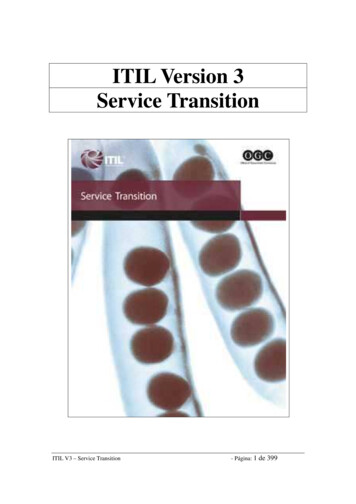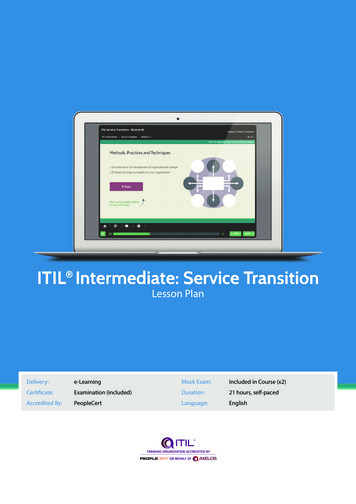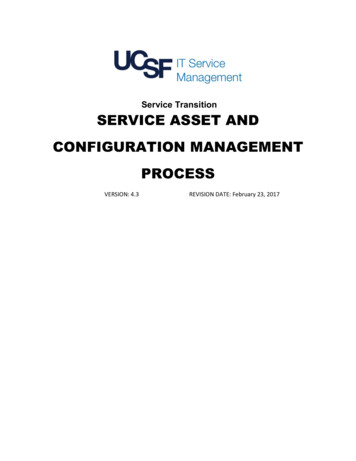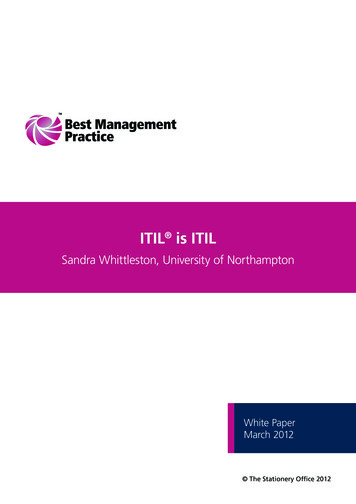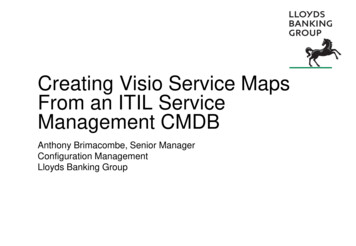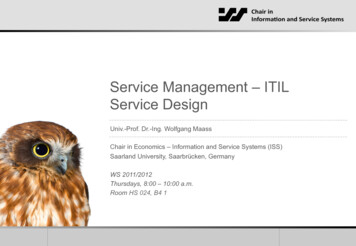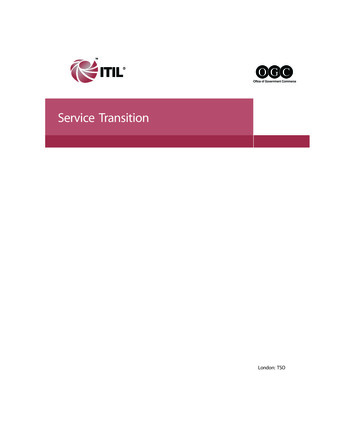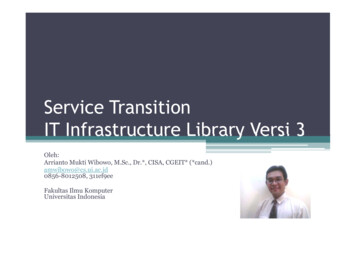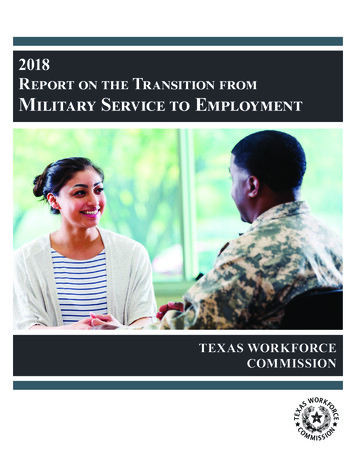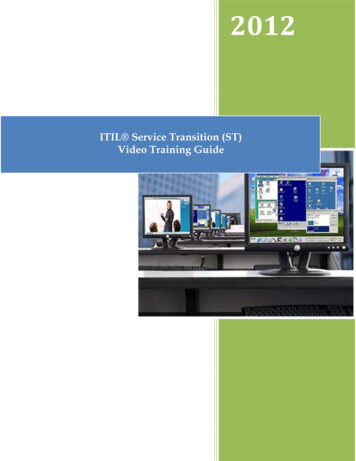
Transcription
2012ITIL Service Transition (ST)Video Training Guide
itSM Solutions LLC31 South Talbert Blvd #295Lexington, NC 27292Phone (336) 510-2885Fax (336) 499-7016PN: ITSMVTGFind us on the web at: http://www.itsmsolutions.com.To report errors please send a note to: support@itsmsolutions.comFor information on obtaining copies of this guide contact: sales@itsmsolutions.comCopyright 2012 itSM Solutions PublishingAuthor: Rick LemieuxNotice of Rights / Restricted Rights LegendAll rights reserved. Reproduction or transmittal of this guide or any portion thereof by any meanswhatsoever without prior written permission of the Publisher is prohibited. All itSM Solutionsproducts are licensed in accordance with the terms and conditions of the itSM Solutions PartnerLicense. No title or ownership of this guide, any portion thereof, or its contents is transferred,and any use of the guide or any portion thereof beyond the terms of the previously mentionedlicense, without written authorization of the Publisher, is prohibited.Notice of LiabilityThis guide is distributed "As Is," without warranty of any kind, either express or implied,respecting the content of this guide, including but not limited to implied warranties for the guide'squality, performance, merchantability, or fitness for any particular purpose. Neither the authors,nor itSM Solutions LLC, its dealers or distributors shall be liable with respect to any liability, lossor damage caused or alleged to have been caused directly or indirectly by the contents of thisguide.TrademarksitSM Solutions is a trademark of itSM Solutions LLC. Hands-On Foundation Certification is atrademark of itSM Solutions Publishing. ITIL is a Registered Trade Mark, and a RegisteredCommunity Trade Mark of the Cabinet Office, and is registered in the U.S.Patent and Trademark Office, and is used here by itSM Solutions LLC under license from andwith the permission from the Cabinet Office (Trade Mark License No. 0002). IT InfrastructureLibrary is a Registered Trade Mark of the Cabinet Office and is used here by itSMSolutions LLC under license from and with the permission of the Cabinet Office (Trade MarkLicense No. 0002). Other product names mentioned in this guide may be trademarks orregistered trademarks of their respective companies.Document Information Texts with this treatment are Alerts, and indicate important concepts.Document: Mentored Learning Video Training GuideRevision date: 2012-02-03Print date: 2012-02-03
ITIL eTrainerMentored Learning Video Training ProgramAlthough this online, web-based course is available to you 24 hours a day, 7 daysa week over the span of your license, you must exercise the same diligence anddiscipline as though you were sitting in a classroom program. The followingtraining plan was designed to help you complete the video, reading and testingcomponents of this ITIL certification program in an orderly fashion.Step #1 - Locate the Important Documents Included within your VideoTraining ProgramPlease make note of four very important printable documents that are includedwith your course. If you have difficulty with the printing options please reachout to support@itsmsolutions.com for assistance. Student Manual & Study Guide – Chapter 1’s table of contents ofcontains a copy of the student manual. The manual includes the instructorslides with amplifying information for each slide, the course syllabus, aglossary along with other support documents. Each video module alsoincludes a student Study Guide which can be used to take notesthroughout the training program. Syllabus – The syllabus for each class is located at the back of the studentmanual. Checkpoint Booklet – The checkpoint guide provides two very differenttypes of study aids to the student. The multiple-choice quiz helps instillthe terminology and knowledge of the subject area while the scenariobased exercises help expand the knowledge gained to fit the context of theoverall business environment. Sample Exams – The last section of each course contains sample examsprovided by the official accreditor for those students looking to sit theactual certification exam.Step #2 – Purchase and read a copy of the ITIL Core Book associated with theclasses you are takingAlthough not mandatory to sit for the exam, the accreditor strongly recommendsthat students purchase and read a copy of the ITIL Core book associated with theclass being purchased. The reading of the ITIL book will help students preparefor the exam in addition to helping them understand how to apply what they justlearned in a real-world environment, ITIL core books can be purchased from ourbook store @ http://www.itgovernanceusa.com/category/291.aspx or atamazon.comStep #3 - Join our Online Mentoring Community & Sign Up for ourContinuing Education Newsletter
The first step in establishing a connection to the mentoring community is tobecome a member of the LinkedIn Group “My ITSM Mentoring Community.”You can do this by going online to the professional networking communitywww.LinkedIn.com, registering as a member (if you are not already a member),and joining the group My ITSM Mentoring Community . You may go directlyto the group by clicking on the “Mentoring Community” link just below the“Login” link on the opening page of the online Learning course.Once you are a member you can post your questions on the discussion board.The discussion board is monitored daily (9 AM to 9PM Eastern Time) by ourteam of ITIL Expert Mentors along with other students taking the online trainingprograms. This forum will enable you to get answers to any questions you mighthave as you go through the program you purchased.Students should also register to receive our periodic Do IT Yourself (DITY)continuing education newsletter. Each newsletter provides practical guidance onthe key topics associated with ITIL and ITSM. Missed an issue? The DITY archive contains all issues organized by topic. Select a topic of interest andbrowse our archive for all the back-issues.Step #4 – Follow the Video Training Plan Listed BelowThe training plan below outlines in order the reading, lectures and testingcomponents a student must complete to successfully prepare for the exam.Please refer to them in the order shown below.If you are attending a scheduled classroom or blended learning program, pleasefollow the schedule outlined by your training provider. If you are taking aremote program, feel free to set up a training schedule that aligns best withpersonal and professional schedules.1. Read the Syllabus Sections Identified in the Video Training PlanThis will help you become familiar with the exam qualification scheme2. Read the Core Publication Sections Identified in the Video Training PlanWhile reading the core books is not mandatory to sit for the exam, the syllabusstrongly recommends it as part of it's prerequiste entry criteria3. Watch the Video Lectures and Reach out to the Community with QuestionsWatch the instructor lectures on video, refer to the student manual for amplifyinginformation, reach out to the community with questions, take notes in the workbook& complete all module exams & checkpoints until you score an 80% or higher4. Take the Sample Exams to Understand your Exam ReadinessReview relevant videos & courseware to shore up problem areas. Reach out to thementoring community for exam taking advice. Work with the training provider toschedule your exam when you have scored an 80% or higher on the sample exams
ITIL Service Transition (ST) Video Training GuideFor each section listed, read the syllabus first followed by the core book section then the video training programSelf-PacedTrainingSchedule(set by thestudent)DatesChapter/Lesson/TopicChapter 1: Course IntroductionObjectivesTerms-to-KnowLesson 1 Course OrganizationWelcome to the Course!Mentoring Community IntroductionsWhy Are You Here?Using Bloom's TaxonomyWhat do you Expect?Housekeeping OnlineLesson 2 Course Conventions & AgendaConventions UsedQuizzes & ExercisesITIL Qualification SchemeITIL Intermediate ExamsGetting Started with an Online ClassEnd of Chapter QuizChapter 2: Service Transition IntroductionObjectivesTerms-to-KnowLesson 3 Introduction to Service TransitionThe Service LifecycleManaging Across the LifecycleThe Service Transition ModelPurpose, Goals & Objectives of Service TransitionScope of Service TransitionValue of Service TransitionLesson 4 Principles of Service TransitionPrinciplesService Transition GovernanceService Transition ManagementThe Service V ModelReadRead the Service TransitionWatch VideosSectiontheSyllabuscore ITIL book sectionslisted belowComplete Section #n/an/a(optional but highlyrecommended)Section /an/an/an/an/an/an/an/an/an/aTake Notes in WorkbookRefer to Coursewarefor Amplifying TextComplete End of ChapterQuizes and CheckpointsVideo #In Student CoursewareIn Student 02ST02SD02n/aST02ST02n/a3.1 to 3.1.143.1.1 to 3.1.53.1.6 to 3.1.11n/a3.1.12 to 3.1.143.2n/aIn Student CoursewareIn Student Courseware1.01.11,21.31.41.51.62.02.12.22.32.4
Service Transition QualityOptimizing Service Transition PerformanceLesson 5 Service Transition SummaryService Transition SummaryCheckpoint InstructionsEnd of Chapter QuizChapter 2 ReviewChapter 3: Service Transition ProcessesObjectivesTerms-to-KnowThe Processes of Service TransitionLesson 6 Planning & SupportIntroductionObjectiveScopeValue to the BusinessConceptsActivitiesDevelop Transition StrategyPrepare for Service TransitionPlan & Coordinate TransitionAdvise Transition TeamsSupport Transition AdministrationMonitor Transition ProgressTriggers, Inputs & OutputsProcess RelationshipsCritical Success FactorsChallenges & RisksSummaryLesson 7 Change ManagementIntroduction to Change ManagementPurpose, Goals & Objectives of Change ManagementScope of Change ManagementValue of Change ManagementConcepts of Change ManagementActivities of Change ManagementThe Change Advisory Board (CAB)Change TypesChange ModelChange ProposalChange Process FlowCreate & Review a Request for ChangeAssess & Evaluate Request for .2.4n/an/aIn Student CoursewareIn Student .92.102.112.122.13
Authorize a ChangeChange Authorization ModelCoordinate ChangeReview & Close ChangeStandard ChangeTriggers, Inputs & OutputsChange Management RelationshipsCritical Success FactorsChallenges & RisksChange Management SummaryLesson 8 SACMIntroductionPurpose, Goals & ObjectivesScopeValue to the BusinessConceptsConfiguration Management SystemDefinitive Media LibraryActivitiesConfiguration Activity ModelManagement & PlanningConfiguration IdentificationConfiguration ControlStatus Accounting & ReportingVerification & AuditTriggers, Inputs & OutputsProcess RelationshipsCritical Success FactorsChallenges & RisksSummaryLesson 9 Release & Deployment ManagementIntroductionObjectiveScopeConceptsValue to the BusinessRelease PackageActivities of Problem ManagementPlanningPrepare Build, Test & DeploymentBuild & TestTest & Pilot ServicePlan & Prepare for g 3n/a4.3.14.3.14.3.24.3.34.3.44.3.44.3.4n/aFig 4.34.44.54.64.74.84.94.14.114.12
Transfer, Deploy & RetireVerify DeploymentEarly Life SupportReview & Close DeploymentReview & Close Service TransitionTriggers, Input & OutputRelationshipsCritical Success FactorsChallengesSummaryLesson 10 Service Validation & TestingIntroductionObjectiveScopeValue to the BusinessConceptsValidation & Testing ProcessActivitiesValidation & Test ManagementPlan & Design TestVerify Test Plan & AcceptancePrepare Test EnvironmentPerform TestEvaluate Exit Criteria & ReportClean Up & CloseTriggers, Input & OutputProcess RelationshipsCritical Success FactorsChallengesSummaryLesson 11 Change EvaluationIntroductionObjectiveScopeValue to the BusinessConceptsEvaluation Point ScopeActivitiesService Evaluation TermsChange Evaluation ProcessEvaluation PlanUnderstand Intended Effects of ChangeUnderstand Unintended Effects of 4.5.14.5.24.5.34.5.4Fig 6.14.6.24.6.34.6.4n/an/an/aFig 6.96.106.116.12
Consider Factors Affecting ChangeEvaluate Predicted PerformanceEvaluate Actual PerformanceManage RiskEvaluation ReportTriggers, Inputs & OutputsRelationshipsCritical Success FactorsChallengesSummaryLesson 12 Knowledge ManagementIntroductionObjectiveScopeValue to the BusinessConceptsDIKW StructureSKMS RelationshipsActivitiesKnowledge Management StrategyKnowledge TransferData & Information TransferService Knowledge Management System (SKMS)Utilization of SKMSTriggers, Inputs & OutputsRelationshipsCritical Success FactorsChallenges & RisksLesson 13 Service Transition SummaryService Transition Process SummaryCheckpoint InstructionsEnd of Chapter QuizChapter 3 ReviewChapter 4: Common ST ActivitiesObjective
ITIL Service Transition (ST) Video Training Guide For each section listed, read the syllabus first followed by the core book section then the video training program Self-Paced Read Read the Service Transition Watch Videos Section Training Chapter/Lesson/Topic the core ITIL book sections Take Notes in Workbook Complete Schedule Syllabus listed below Refer to Courseware for Amplifying Text .
